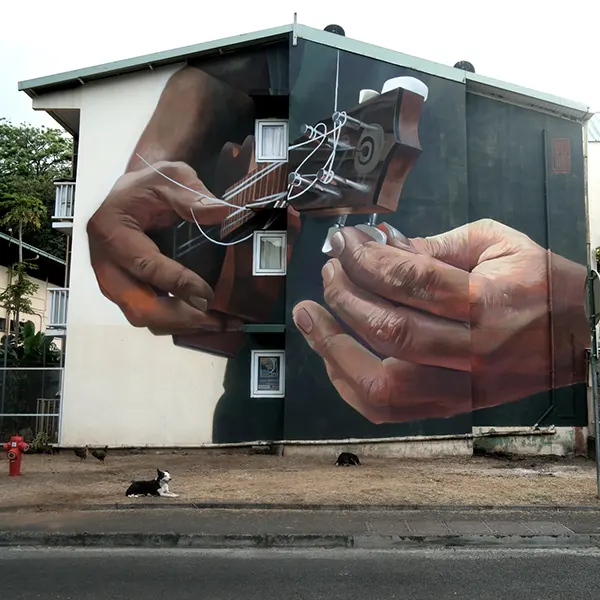Case Study - Grove Street Art and Design Thinking in Public Art
Public art is often described as art for the people, but how often do artists and organizers truly engage with the community to understand their needs and aspirations before placing an artwork in their midst? Inspired by marketing strategies used in the corporate world—where companies invest heavily in understanding their customers through surveys, observations, and feedback—this initiative sought to deeply engage with the Grove Street neighborhood community in Gainesville, Florida. The goal was to create a mural that not only reflects the local culture and history but also resonates with the community, fostering a unique sense of place and identity.
Project Goals
- Site-Specific Research: This project began with a comprehensive study of the site, taking into account the neighborhood’s architecture, traffic patterns, cultural landscape, and the flow of people and activities. Understanding these elements was crucial to ensuring the artwork would be contextually appropriate and meaningful.
- Support for Underserved Sites: A core principle of public art is its accessibility and inclusivity. This project emphasized serving communities that are often overlooked by such initiatives. By choosing the Grove Street neighborhood—an area with rich historical roots but less exposure to public art—the project aimed to bring cultural enrichment to a broader audience.
- Empathy Development through Design Thinking: Central to this project was the application of “Design Thinking,” a methodology that fosters empathy and understanding through direct engagement with all stakeholders, including property owners, business operators, artists, and local residents. This approach helped identify the genuine needs and desires of the community, guiding the creative process towards a more inclusive and thoughtful outcome.
- Identification of Alternatives: The process involved exploring various strategies and solutions that went beyond initial assumptions. This openness to different perspectives ensured that the final artwork would be a true reflection of the community’s spirit, rather than an imposed vision from outside.
The Process
The Grove Street neighborhood, known for its blend of historical charm and emerging modern vibes, provided a rich tapestry for this project. The area is characterized by its “hip,” “Bohemian,” and “trendy” atmosphere, as described by local media. Significant landmarks, such as Gainesville’s oldest home, the Bailey House, and the Dreamers Garden—a space inspired by Jack Kerouac’s “On The Road”—add to the neighborhood’s unique identity.
Community Engagement and Design Thinking
The Monochronicle platform facilitated the selection of Case Maclaim, an internationally renowned artist, to lead the mural project. The “Design Thinking” approach was pivotal from the outset. By engaging with local residents through interviews and community meetings, the project team gained invaluable insights into the neighborhood’s collective identity and values.
One figure emerged prominently in these discussions: Maria Huff Edwards. Maria, a well-known community leader, is deeply involved in various local initiatives, including establishing a community garden and planting trees in vacant lots. Her contributions and the respect she garnered from her neighbors made her an ideal subject for the mural. Her story embodied the spirit of the Grove Street neighborhood—a spirit of community, resilience, and growth.
The Mural
Reflecting this spirit, the mural designed by Case Maclaim featured Maria Huff Edwards at its center, symbolizing her role as a nurturer and leader within the community. The artwork integrates elements that resonate with the neighborhood’s culture and history, ensuring that it is not just a decorative addition, but a meaningful reflection of the community’s identity.
Outcomes and Impact
The mural has become a landmark within the Grove Street neighborhood, serving as a visual representation of the community’s shared values and history. The project has demonstrated the power of community-driven public art to foster a sense of place and belonging. It also underscored the importance of empathy and engagement in the creative process, aligning with the broader goal of using art to enhance community cohesion and identity.
Funding and Support
This project was funded in part by the Florida Department of State’s grant, recognizing the importance of supporting public art initiatives that are inclusive, community-focused, and culturally enriching.
Conclusion
This case study illustrates how a thoughtful, community-engaged approach to public art can lead to outcomes that are not only aesthetically pleasing but also deeply meaningful to the people who experience them daily. By prioritizing empathy, inclusivity, and local relevance, public art can truly become a reflection of the community it serves, fostering a unique sense of identity and pride among its residents. Read more about the Design Thinking approach in public art here.
- Experience: submit one image of your previous work



